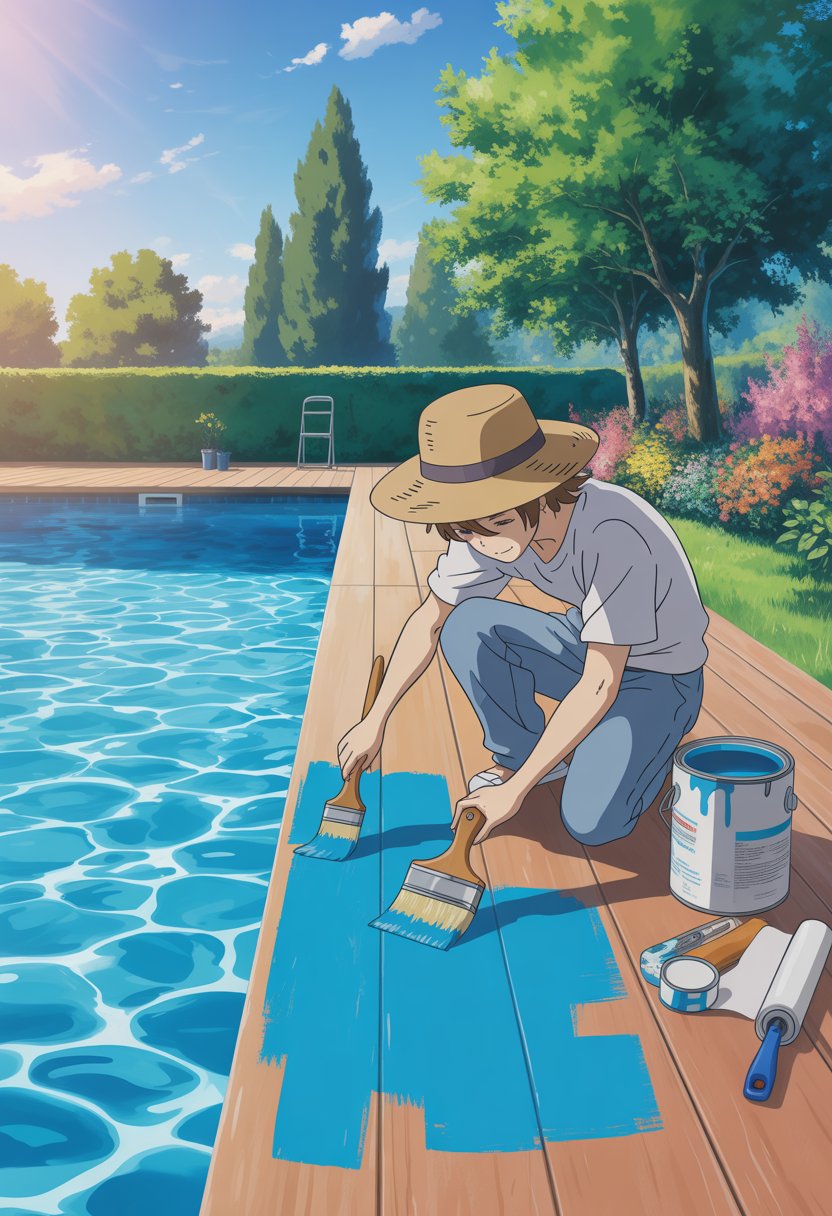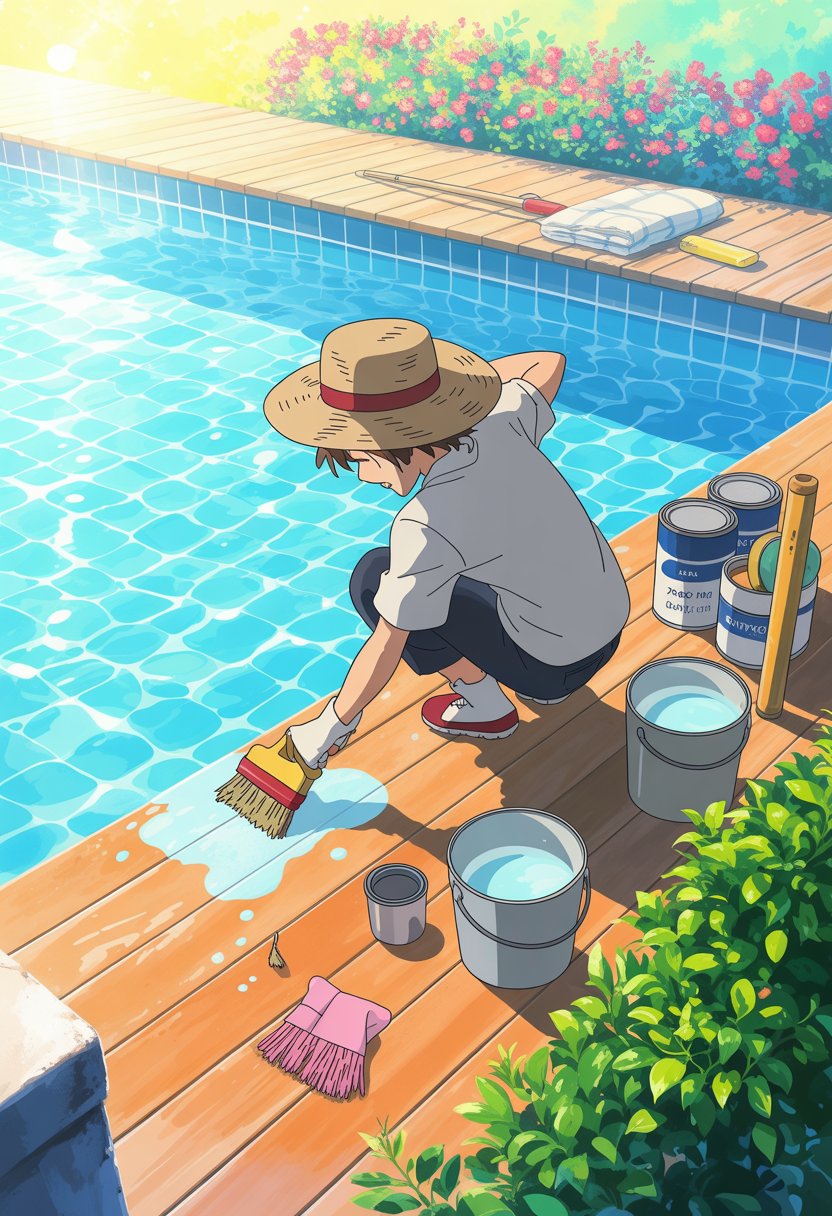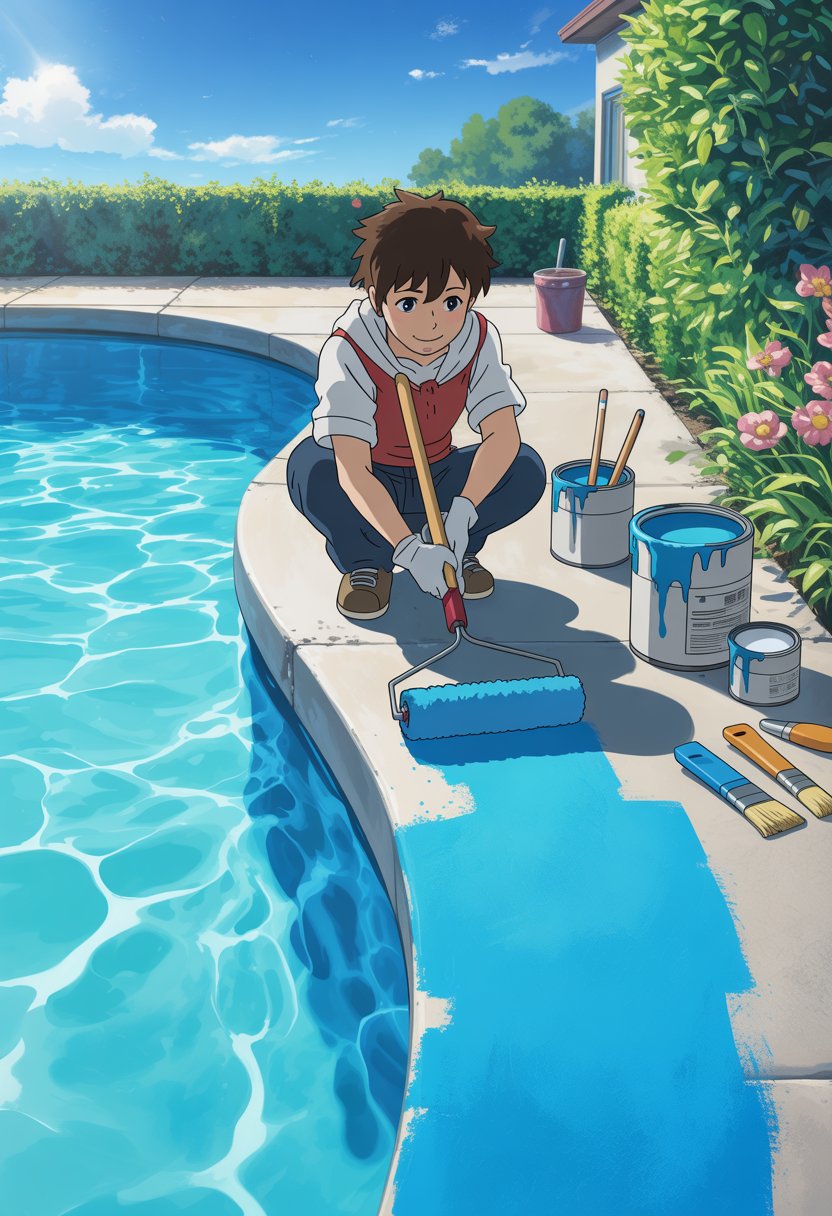How To Paint A Pool Deck: Step-by-Step for Lasting Results
A worn-out pool deck can make your whole backyard feel tired and uninviting. Instead of shelling out thousands for a full replacement, you can paint your pool deck and totally refresh your outdoor space—sometimes in just a weekend. Painting a pool deck means cleaning the surface, picking slip-resistant paint made for outdoors, and rolling it on in thin, even coats for a finish that looks good and helps keep things safe.

You’ll need a little planning and the right supplies, but honestly, the results are worth it. A new coat of paint not only protects your deck from water and sun but also lets you update the color and vibe—without the huge price tag. Plus, a good paint job keeps your deck looking sharp for family hangouts and pool parties, and it can even bump up your home’s value.
Get the Fail-Safe Paint Color Playbook (Free PDF)
36 proven colors • 8 ready palettes • trim & sheen guide • printable testing cards.
Whether your deck is concrete, wood, or composite, what really matters is good prep and picking the right paint. Every step—from cleaning to the last touch-up—really does make a difference if you want something that’ll hold up against pool chemicals, wild weather, and all those summer feet running around.
Why Paint Your Pool Deck?
Painting your pool deck comes with three big perks: it upgrades your outdoor look, shields concrete from harsh weather, and makes the area around your pool safer to walk on. Not bad for a weekend project, right?
Boosting Curb Appeal
A painted pool deck can totally change the feel of your backyard. Old concrete usually looks gray, stained, and just kind of sad after a few years.
Pool deck paint comes in all sorts of shades, so you can pick something that fits your style. Maybe you want light blues to match the pool, or maybe you’re more into warm beiges that go with your house.
Popular color choices include:
- Light gray for a modern look
- Tan or beige for a natural feel
- Blue tones to complement pool water
- White for a clean, bright appearance
The right paint color makes your pool area look fresh and inviting. If you like hosting parties (or just want your backyard to look good for yourself), this is an easy win.
Painting also helps everything outside come together. Suddenly, your pool, patio, garden, and furniture all feel like they belong in the same space.
Protecting Surfaces from Weather Damage
Unpainted concrete soaks up water, chemicals, and sunlight, and that messes it up over time. Painting your pool deck puts a barrier between your concrete and all the stuff that wants to wreck it.
Paint protects against:
- UV damage that fades and weakens concrete
- Water absorption that leads to cracks in winter
- Pool chemicals that stain and eat away at surfaces
- Salt damage from pool water splashing
When you skip protection, little cracks start showing up and just keep getting bigger every year. Water gets inside, freezes, and then you’ve got an even bigger problem.
A quality paint job can make your deck last years longer. That means more money in your pocket instead of spending it on repairs or a new deck.
Painted decks are also way easier to clean. Sealed surfaces don’t grab onto stains, so dirt and algae come off with less scrubbing.
Improving Safety and Slip Resistance
Let’s be honest—wet concrete near a pool is a slip-and-fall waiting to happen. The right deck paint adds texture for better traction, so everyone has a safer time.
Get the Fail-Safe Paint Color Playbook (Free PDF)
36 proven colors • 8 ready palettes • trim & sheen guide • printable testing cards.
Many pool deck paints have texture built in, or you can stir in something gritty to give it a little extra grip. That way, even when the deck’s wet, you’re less likely to go sliding.
Safety benefits include:
- Better grip when walking barefoot
- Reduced slipping on wet surfaces
- Safer entry and exit from pool areas
- Protection for children and elderly family members
If you want, you can add slip-resistant additives to regular paint. Tiny grit particles mix right in and give the surface just enough “bite” when it dries.
Don’t go overboard, though—you want grip, not sandpaper. The right balance keeps bare feet comfortable but still safe.
Some paints even reflect heat better than plain concrete, so your deck won’t get as scorching on hot days. That’s a small detail, but your feet will thank you.
Preparing the Pool Deck for Painting

If you want your paint job to last, prep is everything. Cleaning gets rid of dirt and junk that messes with paint sticking, and fixing damaged spots gives you a smooth finish that won’t peel up in a year.
Cleaning with a Pressure Washer
First, move all the furniture and stuff off your pool deck. Give it a good sweep to clear away leaves and dirt before you get out the hose.
Grab a pressure washer—1500-3000 PSI is plenty for concrete. Use a wide spray nozzle so you don’t gouge the surface. Hold the nozzle about a foot from the deck.
Work in sections. Spray at a slight angle so you’re pushing water away from your house. You don’t want to flood your siding or windows.
For tough stains, put down some concrete cleaner and let it soak for 10-15 minutes before you wash. Oil stains are stubborn, so hit them with a degreaser.
Power wash the whole deck at least once—twice if it’s really dirty. The first go knocks off the top layer of dirt, and the second gets what’s left.
Get the Fail-Safe Paint Color Playbook (Free PDF)
36 proven colors • 8 ready palettes • trim & sheen guide • printable testing cards.
Pay extra attention to the pool edge where chlorine and chemicals build up. Those spots usually need more elbow grease.
Repairing Cracks and Surface Damage
Take a good look at your deck before you paint. Check for cracks, holes, and rough spots that need fixing.
For small cracks, use concrete crack filler and a putty knife. Press it in deep and smooth it out with the surface.
Bigger cracks (over 1/4 inch wide) need concrete patching compound. Clear out loose bits first, then fill in thin layers if it’s deep.
Concrete resurfacer is great if you’ve got lots of little cracks or a rough surface. Mix it up and spread with a squeegee or trowel.
Once repairs are dry, sand down any high spots or rough patches. 80-grit sandpaper works well for concrete. You want a smooth, even base for painting.
Check that all your patches are level with the rest of the deck. If not, they’ll stick out after you paint, and nobody wants that.
Ensuring a Dry Surface and Proper Conditions
Wait at least a day or two after pressure washing before you paint. Concrete can look dry but still hold moisture underneath.
Here’s a quick test: tape a piece of plastic to a few spots on your deck and leave it for 24 hours. If there’s condensation underneath, give it more time to dry.
Get the Fail-Safe Paint Color Playbook (Free PDF)
36 proven colors • 8 ready palettes • trim & sheen guide • printable testing cards.
Always check the weather. You need at least two days of dry weather—no rain in the forecast.
Best painting conditions are between 50 and 85°F, with low humidity. Try to avoid painting in direct sun when it’s blazing hot.
Wind can blow dust onto wet paint, so pick a calm day or put up some makeshift barriers if you have to.
Don’t paint if the deck surface is hotter than 90°F. Hot concrete makes paint dry too fast and it won’t stick right. If you’re not sure, check with an infrared thermometer.
Morning is usually the sweet spot—the deck’s cool and humidity isn’t too high.
Choosing the Best Pool Deck Paint

The right pool deck paint keeps your deck looking good and protected from the elements. Epoxy and acrylic each have their pros, and some finishes help prevent slips and fading.
Types of Pool Deck Paint
There are two main types that work for most decks: acrylic and epoxy. Each one has its own strengths.
Acrylic pool deck paint usually lasts around five years and doesn’t cost much. It works in most climates and comes in a bunch of colors. Acrylic breathes better, so it’s less likely to peel.
Epoxy paint gives you a hard, glossy finish but generally lasts about two years. It’s more expensive but stands up better to chemicals and stains. Epoxy’s best for cooler climates since heat can mess with it.
Concrete stains are another option—they soak in and last longer than paint, but you don’t get as many color choices.
Think about your local weather. If you get a lot of sun, look for UV-resistant paint. If it’s rainy, pick something that handles moisture well.
Understanding Epoxy Paint and Other Options
Epoxy paint makes a tough, glossy surface that stands up to chemicals and wear. It bonds to concrete and can even fill in small cracks as it cures.
But here’s the catch: Epoxy doesn’t love heat. In super hot places, it can soften up. Also, it gets slippery when wet unless you add some texture.
Two-part epoxy systems (where you mix resin and hardener) give the strongest finish, but you have to mix and apply them pretty quickly. Single-part epoxy paints are easier, but not quite as tough.
Acrylic paints are usually cheaper and handle heat better. They dry fast and clean up with water. These days, a lot of acrylics have ceramic beads or sand mixed in for better grip.
Polyurethane coatings are another option, landing between acrylic and epoxy for durability. They’re good against UV rays and stay flexible even when temps swing.
Selecting Non-Slip and UV-Resistant Finishes
If you want a safe pool area, go for paint with built-in traction. Textured finishes help prevent slips when things get wet.
Look for paints with sand, aluminum oxide, or ceramic beads mixed in. These make the surface grippier. Some paints let you add your own grit if you want to tweak the texture.
UV-resistant formulas keep paint from fading and chalking in the sun. If you skip this, your deck could lose color or start peeling after just a year in bright spots.
Check the label for:
- Slip-resistant additives
- UV stabilizers
- Heat-reflective properties
- Mildew resistance
Cool deck paints reflect more heat, so your deck stays comfortable to walk on. Some claim to drop surface temps by 30 degrees or more—not bad if you hate burning your feet.
Always test a textured finish in a small area first. Too much texture can feel rough on bare feet, and nobody wants that. Get it just right for safety and comfort.
Essential Tools and Materials for Deck Painting
The right tools make all the difference between a pro-looking finish and a job you wish you could redo. Good brushes, rollers, and primers made for pool decks help you get solid coverage and a finish that actually lasts.
Paint Rollers, Brushes, and Sprayers
You want decent brushes and rollers so your pool deck paint goes on smooth. They help you avoid streaks and give you better coverage—no one likes a patchy-looking deck.
If you’re tackling a big area, grab a 9-inch roller with a thick nap sleeve. That thick nap holds more paint and gives concrete a nice texture.
For edges and corners, angled brushes (2 to 4 inches wide) are easier to handle. They let you get in close around pool gear or tight spots without making a mess.
Essential application tools:
- 9-inch paint roller with extension pole
- Thick nap roller sleeves (3/4 inch or 1 inch)
- Metal roller tray with liners
- 2-inch and 4-inch angled brushes
- Drop cloths to protect surrounding areas
Paint sprayers can speed things up on massive decks, but honestly, they’re tricky if you haven’t used one before. You might end up wasting paint, so maybe stick with rollers unless you’re feeling confident.
Primers and Sealers for Long-Lasting Results
A good primer helps paint stick and keeps it from peeling off in a year or two. Skipping primer? You’ll probably regret it later.
Pick a concrete primer made for outdoor use. These handle moisture and temperature swings way better than standard primers.
Apply primer with the same roller and brush you’ll use for paint. That way, you get the same texture across the whole deck.
Recommended primer features:
- Moisture resistance
- UV protection
- Fast-drying formula
- Compatible with your chosen paint type
Some pool deck paints have primer mixed in. They’re convenient, but in my experience, separate primer and paint usually hold up longer (details here).
Let the primer dry all the way before painting. Drying times vary, so check the label or see more info here.
Safety Gear and Preparation Supplies
Don’t skip safety gear. Paint fumes and chemicals aren’t great for your lungs or eyes, especially when you’re working outside for hours.
Wear safety goggles and a respirator mask, especially when dealing with primers. Some of this stuff is strong and can really irritate you.
Essential safety equipment:
- Safety goggles
- Respirator mask (N95 or better)
- Chemical-resistant gloves
- Long-sleeved shirt and pants
- Non-slip shoes
Blast off dirt, old paint, and debris with a pressure washer. Stick to a wide spray nozzle so you don’t chew up the concrete.
Painters tape is a must for protecting pool gear and getting crisp lines. Outdoor tape is best—it won’t leave sticky gunk behind.
Find and fill any cracks with concrete filler before you paint. It’s a little extra work, but it makes a huge difference in the end.
How to Paint a Pool Deck: Step-by-Step
If you want your deck to last, don’t rush prep or painting. Masking keeps paint out of your pool, primer helps paint stick, and the right tools make the finish look even.
Masking and Protecting Surrounding Areas
First, clear off all the furniture and decorations. Cover your pool with plastic sheeting or tarps—paint splatters in the water are a pain to clean.
Use painter’s tape to mask off anything you don’t want painted. Go around pool coping, rails, and siding, pressing the tape down hard so paint doesn’t sneak underneath.
Drop cloths protect plants and landscaping. Plastic sheeting is good for big areas, but canvas drop cloths work better on walkways since they won’t blow away as easily.
Wrap pool equipment like pumps and filters with plastic bags. Tape or rubber bands keep them sealed up.
Double-check that you’ve covered all electrical outlets and lights. You really don’t want paint getting in there.
Applying Primer for Better Paint Adhesion
Start with a primer made for your deck’s material—concrete or wood. This step matters more than you might think.
Pour primer into a tray. Use a roller with a 3/8-inch nap for smooth decks, or 1/2-inch for textured concrete.
Begin in a corner farthest from your exit. Roll the primer in overlapping W shapes so you don’t miss spots.
Cut in around edges and corners with a brush. Work pretty quickly to keep a wet edge and avoid weird lines.
Let the primer dry fully before you break out the paint. Usually, it takes 2-4 hours, but check the label to be sure.
Once it’s dry, scan for missed spots and touch them up before you move on.
Painting Techniques for Even Coverage
Pick a pool deck paint with slip resistance. Epoxy paint is a solid choice for busy areas—it just holds up better.
Pour the paint into a clean tray. Stick with the same roller nap you used for primer. Start in the same corner as before for consistency.
Get the Fail-Safe Paint Color Playbook (Free PDF)
36 proven colors • 8 ready palettes • trim & sheen guide • printable testing cards.
Roll on thin, even coats with overlapping strokes. Don’t glob on thick paint—it won’t dry right and looks uneven. Two thin coats almost always look and wear better.
Keep a wet edge as you go. That just means you’re painting into still-wet paint, not dragging your roller over dried bits.
Use a brush for detail work and tight corners. Keep a damp rag nearby for drips—you’ll thank yourself later.
Let the first coat dry before adding a second. Most deck paints need 4-6 hours between coats. That second coat really locks in the color and helps it last.
Caring for a Painted Pool Deck
Want your painted pool deck to look good for years? Regular cleaning, quick touch-ups, and a little prevention go a long way. It’s not rocket science, but it’s worth the effort.
Routine Cleaning and Maintenance
Give your pool deck a cleaning at least once a month to keep dirt from piling up. A pressure washer or hose blasts off leaves and dust in no time.
If you spot tough stains, mix up some water and mild soap. A stiff brush helps scrub away algae or mold, especially in shady spots.
Weekly maintenance tasks:
- Sweep up loose debris
- Rinse with water after pool use
- Look for standing water
Monthly deep cleaning:
- Use a pressure washer on low
- Apply a mild cleaner to stains
- Rinse well and let it dry completely
Skip harsh chemicals or bleach. They can wreck the paint finish and make the surface slippery—nobody wants that.
Clean up spills as soon as you notice them. Pool chemicals, food, and drinks can stain if you leave them too long.
Touch-Ups and Repainting
Every few months, check your deck for signs of wear—cracks, peeling, chips, or faded spots. Catching problems early makes touch-ups easier.
Save leftover paint from your original project for future fixes. Store it somewhere cool and dry, with the lid tight.
Signs you need touch-ups:
- Small chips or scratches
- Faded spots from heavy use
- Minor peeling at the edges
- Discoloration from pool chemicals
For small repairs, clean and lightly sand the area. Prime if needed, then touch up with matching paint.
Plan to repaint the whole deck every 3 to 5 years. If your deck gets a lot of use, you might need to do it sooner.
Hot, sunny weather can fade paint faster than mild climates, so keep an eye on color changes if you live somewhere warm.
Preventing Common Issues
If you want your deck paint to last, it’s smart to tackle little problems before they turn into big headaches. Try slipping furniture pads under chairs and tables—those legs can be sneaky scratch-makers.
Common prevention strategies:
Get the Fail-Safe Paint Color Playbook (Free PDF)
36 proven colors • 8 ready palettes • trim & sheen guide • printable testing cards.
- Drop down pool mats where everyone walks the most
- Keep pool chemicals well away from the deck surface
- Trim nearby plants so moisture doesn’t linger
- Jump on drainage issues as soon as you spot them
Keep an eye out for water pooling on the deck. Standing water isn’t just bad for the paint; it can make things pretty slippery, too.
Every couple of years—or three, if you’re lucky—brush on a new coat of sealer. That extra layer helps your pool deck paint stand up to the sun and chemicals.
It also pays to trim back trees near the deck. Too much shade and falling branches? That’s just asking for mold and mildew.
Glance at the caulk lines around your deck now and then. If you spot cracks or missing sections, swap them out to keep water from sneaking under the paint.
